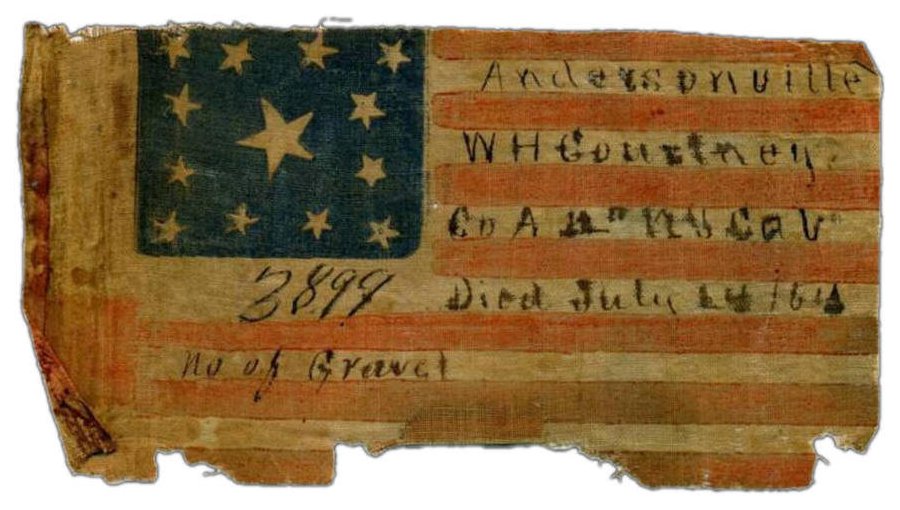
This 13 Star American Parade Flag is one of the most
poignant and historically fascinating parade flags one
can encounter. Civil War era flags rarely have such
precise history and personal provenance as this flag.
The actual soldier who carried the flag and preserved it
is unknown, but most likely he too was assigned to
Company A, 12th New York Cavalry, and was captured along
with Private William H. Courtney (Cortney) and
imprisoned along with Private Courtney at the
Andersonville Prison in Andersonville, Georgia.
During the Battle of Plymouth, North Carolina, Company A
and Company F of the 12th New York Cavalry sustained
significant losses in men killed, wounded and captured.
Confederate forces under the command of Maj. Gen. Robert
F. Hoke attacked the Federal Garrison at Plymouth, NC on
April 17. On April 19, the Union Navy supporting the
garrison was driven off by the CSS Albemarle.
Confederate forces first captured Fort Comfort, driving
the defenders to nearby Fort Williams. On April 20,
1864, Fort Williams also surrendered to the Confederate
forces. According to records, 125 men from A and F Co.
were captured during the four days of the battle between
the 17th and 20th of April, 1864. Among those captured
was young Private William H. Courtney, who at the age of
26 enlisted in the 12th Cavalry from his home in Oswego,
New York. The tragedy that befell the men of these units
is that they were captured and transferred to
Andersonville, Georgia, the most notorious prison in the
Confederate prison system. While in operation, the
prison received over 45,000 soldiers and of those,
12,913 died of disease and starvation. During the summer
of 1864, the soldiers suffered greatly from heat,
disease and malnourishment. Within seven months, nearly
a third of them died from dysentery and scurvy. A Union soldier
described his entry into the prison camp:
"As we entered the place, a spectacle met our eyes
that almost froze our blood with horror, and made our
hearts fail within us. Before us were forms that had
once been active and erect "stalwart men", now nothing
but mere walking skeletons, covered with filth and
vermin. Many of our men, in the heat and intensity of
their feeling, exclaimed with earnestness. "Can this be
hell?" "God protect us!" and all thought that He alone
could bring them out alive from such terrible a place.
In the center of the whole was a swamp, occupying about
three or four acres of the narrowed limits, and a part
of this marshy place had been used by the prisoners as a
sink, and excrement covered the ground, the scent
arising from which was suffocating. The ground allotted
to our ninety was near the edge of this plague-spot, and
how we were to live through the warm summer weather in
the midst of such fearful surroundings, was more than we
cared to think of just then."1
It was under these conditions that young Private William
H. Courtney died on July 14, 1864. A fellow soldier and
friend, unknown to history, carried this flag and wrote
upon it Private Courtney's date of death and the grave
number to preserve his memory and to one day
present to his loved ones. While soldiers are known to
have carried with them small parade flags, sometimes
sewn into their uniforms, the survival of these flags,
especially with such hand written provenance and
historical significance is extremely rare. The wear and
soiling of the flag are reminders of the horrid conditions
the soldiers endured in the prison camp, making this
small, beautiful flag one of the most personal and
poignant relics to have survived the American Civil War.
Among the 125 men originally captured from A Co. and F
Co., 12th NY Cavalry, 8 men escaped, 47 men were paroled
and survived capture, and the remaining 70 men died in
Confederate Prison in 1864 (1 at Charleston, SC., 4 at
Florence, SC, and 65 at Andersonville, GA, most during
the summer of 1864.).
Additional Historical Context and Family Legacy
Recent correspondence with Rosemary Vergin, historian of
the Geer Family Association, has provided valuable
insights into Private William H. Courtney's family
history and lineage. Private Courtney, born July 9,
1837, in Oswego, NY, was the son of Susanann Geer and
William Thomas Courtney. Susanann Geer, a descendant of
Benajah Geer—a Revolutionary War veteran wounded at
Bunker Hill—passed away in 1857 at age 40. William
Thomas Courtney, a sailor, tragically drowned at sea
circa 1849-50.
William had two siblings: his sister Anna Elizabeth
"Eliza" Courtney (1842–1920) and his brother Abaellino
George Courtney (1840–1903). Abaellino served as a
drummer in Company B, 24th New York Volunteer Infantry,
and later married Juliette Victoria Calkins in 1867. His
son, Dr. Abine George Courtney, became Commander of the
New York State chapter of the Sons of Union Veterans to
honor his father’s and uncle’s service during the Civil
War. Dr. Courtney also played prominent roles in civic
organizations, carrying on the family’s proud legacy of
service and historical preservation.
The Geer Family Association has also highlighted the
contributions of other family members, including
Abaellino’s daughter, Etta Avis Courtney, who was active
in the Daughters of the American Revolution and the
Mayflower Society, connecting the Courtney family to
America’s earliest settlers.
Rosemary Vergin and the Geer Family Association have
shown great interest in the flag and plan to include its
image and story in their Spring 2025 newsletter,
ensuring that Private Courtney’s sacrifice and this
flag’s significance are preserved for future
generations. The flag remains a powerful reminder of the
courage, sacrifice, and resilience of Union soldiers
during one of the most challenging periods in American
history.
1Kellogg, Robert H. Life and Death in Rebel Prisons.
Hartford, CT: L. Stebbins, 1865. |

